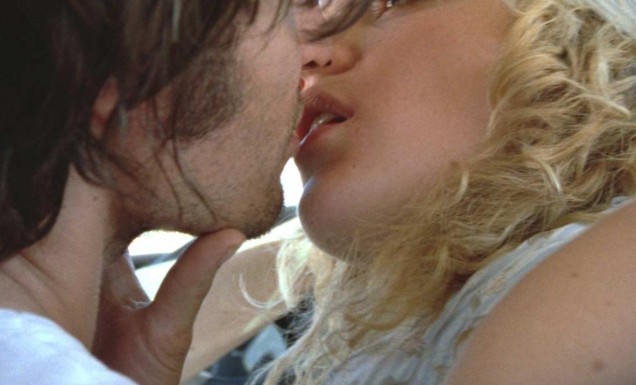The Brown Bunny
film ceste, USA, Japan, 2003
DIRECTED BY: Vincent Gallo

CAST:
Vincent Gallo,
Chloë Sevigny
SCRIPT:
Vincent Gallo
PHOTOGRAPHY:
Vincent Gallo
MUSIC:
Jackson C. Frank,
Jeff Alexander,
Gordon Lightfoot,
Ted Curson,
Accardo Quartet,
John Frusciante
EDITING:
Vincent Gallo
Synopsis:
After finishing the race in the American state of New Hampshire on the east coast, motorcyclist Bud Clay starts his journey to the west coast, where he will participate in the next race. Bud is a lonely man who remembers his one true love, Daisy, and on his way to California he meets and befriends several women, but none of them can alleviate his alienation and sadness...
Cult actor Vincent Gallo, the child of Italian parents from Sicily, began his artistic career during the 1980s as a painter and musician, and in the same decade he also started acting, but he truly asserted himself in the 90s, in prominent films such as Martin Scorsese's Good Guys, Emir Kusturica's Arizona Dream and Bille August's Ghost House. Zarana started directing short films, and of the three feature-length productions, he is best known, due to the enormous controversy, entitled Smeđi zec. The film was premiered in the main program of the world's biggest festival, the one in Cannes, where it had a terrible reception, and the famous critic Roger Ebert wrote that it was the worst film ever shown at the Cannes festival. The majority of the audience booed the film and left the screening, but among those who remained there were some who saw it off with several minutes of applause. After a bad reaction from the audience and critics at Cannes, Gallo shortened the film by twenty minutes and that version was released in limited distribution in American theaters, where it was better received by critics, including Ebert himself, who gave the new version a positive rating.
Brown Rabbit is a low-budget independent production shot on 16mm tape, in which Gallo plays his own alter-ego (he himself was a professional competitive motorcyclist in his youth), and his co-star is Chloe Sevigny, the biggest star of independent films at the time, with whom he used to be in intimate relationships. It was precisely because of this mutual closeness that Sevigny agreed to film a scene of unsimulated fellatio with Gallo, one of the most famous sexual scenes in the history of non-pornographic cinematography. Gallo is a worldview conservative, an opponent of alcohol, drugs and pornography, and he imagined that scene as a deeply intimate act between two people, and not as a scene that should excite the audience or arouse their sexual imagination.
Rarely has a film in the history of cinema encountered such conflicting reactions as The Brown Rabbit, so against the prevailing disparagement, the claim that it is a vain pretentious and boring achievement, stand such authorities as Jean-Luc Godard, John Waters, Sean Penn and Werner Herzog who celebrated the film, and Herzog described it as "the best portrait of the special loneliness that man feels". The famous French magazine Cahiers du cinéma ranked it among the ten best films of the year, and the American independent filmmaker Joshua Safdie (a member of the prominent auteur duo the Safdie brothers) went much further - in a 2012 survey by Sight & Sound magazine, he included it in the top ten movies of all time.
Author of the text: Damir Radić
color, 93'